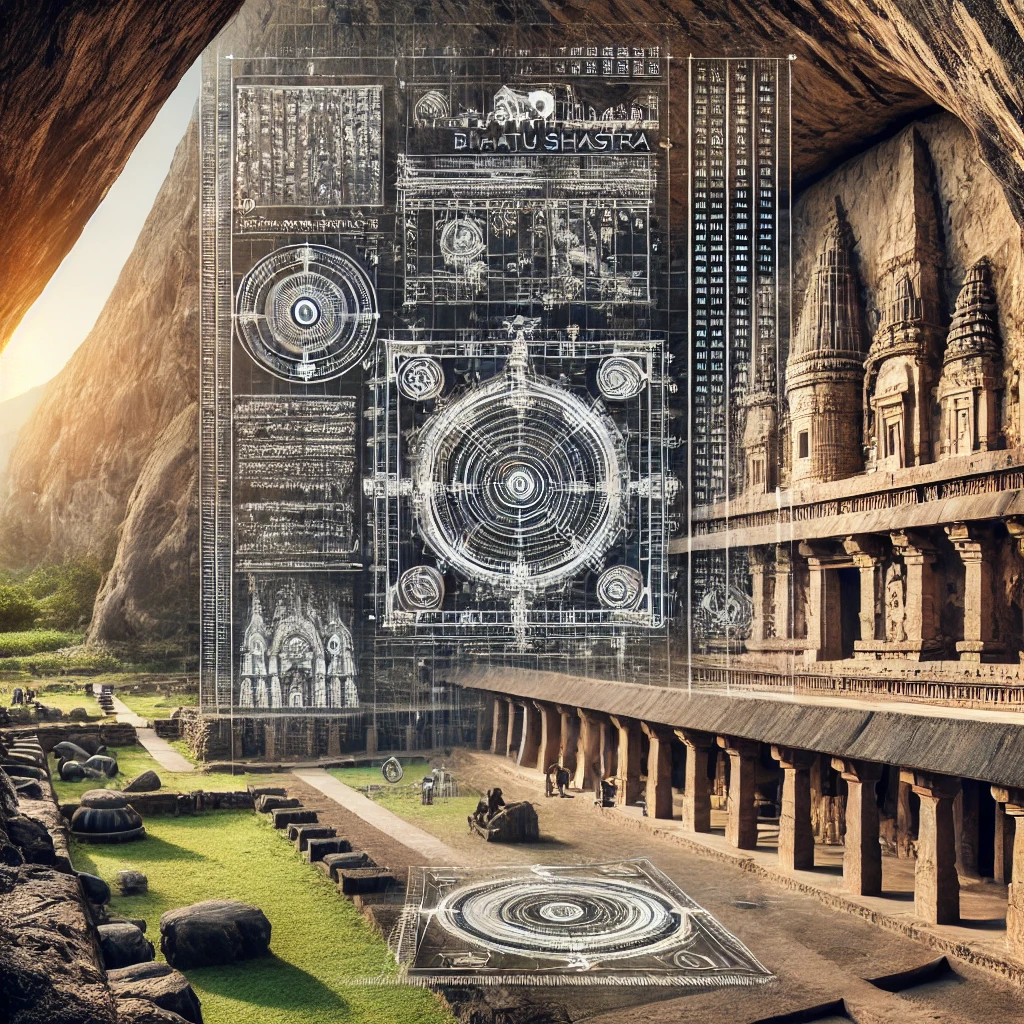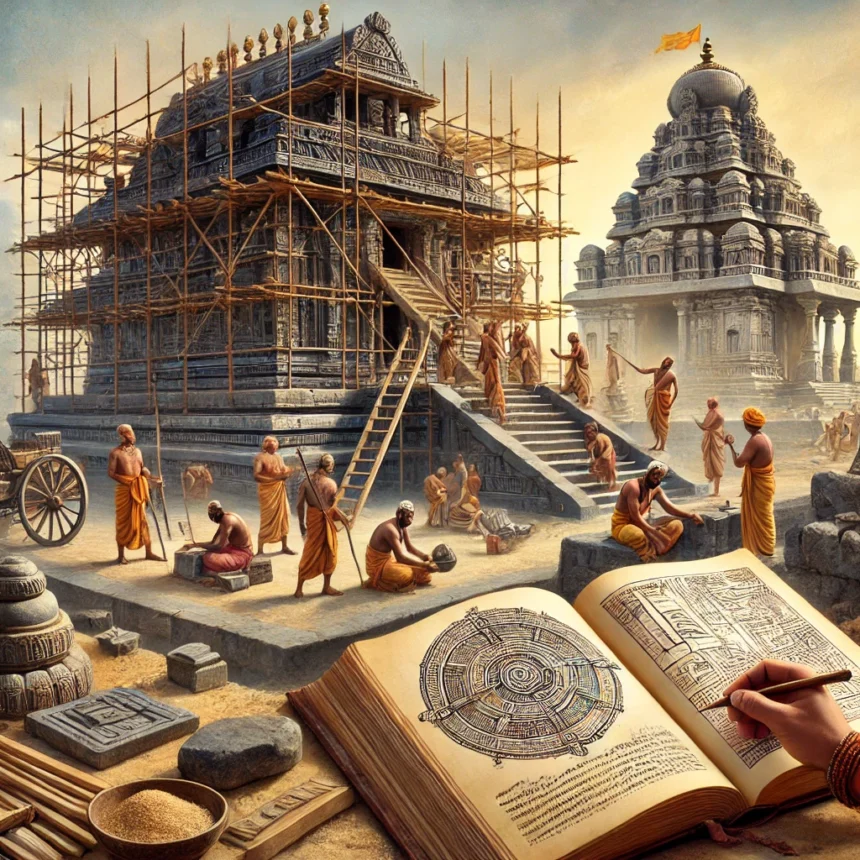Vedic Science Building Technology: Additional Texts and Evidence-II
Deep Dive into Vedic Science Building Technology Applicability
Vedic Science Building Technology encompasses a rich and diverse array of ancient Indian texts, inscriptional evidence, and architectural marvels. This blog explores the Brihat Samhita, Vastu Shastra, and the remarkable rock-cut architecture of the Ajanta Caves. By examining these sources, we gain insight into the principles and practices of Vedic Science Building Technology, including its emphasis on sustainability, resilience, and harmony with nature. These principles are essential for creating buildings that are not only beautiful and durable but also environmentally friendly and sustainable.
In this blog, we will explore the Brihat Samhita, Vastu Shastra and study evidence evidence of Vedic knowledge from Ajanta and Ellora. We will examine the techniques and materials used in ancient Indian construction and discuss the significance of these practices for modern sustainable building.
Brihat Samhita and Vastu Shastra Texts
The ancient Indian texts of Brihat Samhita and Vastu Shastra provide valuable insights into the principles and practices of Vedic Science Building Technology. By studying these texts, we can gain a deeper understanding of the techniques and materials used in ancient Indian construction, and how these can be applied to modern building practices.
Brihat Samhita: Guide to Vedic Science Building Technology
The Brihat Samhita, an ancient Indian text on architecture and construction, provides detailed recommendations for grinding ingredients for plaster and mortar. This text, a key resource for Vedic Science Building Technology, emphasizes the importance of using natural materials and minimizing waste in construction.
According to the Brihat Samhita, the process of grinding ingredients for plaster and mortar involves the use of natural materials such as limestone, sand, and plant fibers. The text recommends using a combination of these materials to create a strong and durable mortar. This approach to mortar preparation is a key aspect of Vedic Science Building Technology, and is still used today in many traditional building practices.
As an anecdote we give the evidence of coatings as details below.
In fact, Chapter 57 of the Brihat Samhita provides a specific recipe for a durable coating, known as “Vajralepa”. The text describes the preparation of this coating as follows:
आमं तिन्दुकमामं कपित्थकं पुष्यमपि च शाल्मल्याः ।
बीजानि शल्लकीनां धन्वनवल्को वचा चेति ॥९॥
एतैः सलिलद्रोणः क्वाथयितव्योऽष्टभागशेषश्च ।
अवतार्योऽस्य च कल्को द्रव्यैरेतैः समनुयोज्यः ॥२॥
श्रीवासकरसगुग्गुलुभल्लातककुन्दुरूकसर्जरसैः ।
अतसीबिल्वैश्च युतः कल्कोऽयं वच्रलेपाख्यः ॥३॥
Translation: “Take unripe 1 Tinduka fruits, unnpewood-apples, flowers of silk cotton, seeds of Sallaki, the bark of Dhanvana and Vacha ; boil them all in a Drona (256 Palas ) of water and reduce it to an eighth of its original volume. Combine the sediments with the following substances, viz, , Srivasaka (a secretion of a tree used as incense), Raktabola, Guggulu, Bhallataka, Kunduruka(the exudation of Deodar), the exudation of Sarjarasa tree, Atasi and Bilvva fruit. This paste is termed Adamantine glue”, By V Subrahmanya Sastri.
This Vajralepa coating is said to be incredibly durable, lasting for over a crore (10 million) years. The text states:
प्रासादहर्म्यवलभीलिङ्गप्रतिमासु कुङ्यकूपेषु ।
सन्तप्तो दातव्यो वर्षसहस्रायुतस्थायी ॥४॥
Translation: “When this glue, being heated, is applied to temples, mansions, windows, Siva’s emblems, idols, walls and wells, it will last for a crore of years,” By V Subrahmanya Sastri.
The Brihat Samhita’s emphasis on using natural materials and minimizing waste is also reflected in its recommendations for construction practices. The text advises builders to use local materials, minimize waste, and optimize energy efficiency in construction. These principles are central to Vedic Science Building Technology, and are essential for creating sustainable and resilient buildings.
Practical examples of the use of these techniques in ancient Indian construction can be seen in the many temples and monuments that still stand today. The use of natural materials and minimizing waste in construction allowed ancient Indian builders to create structures that were not only beautiful and durable but also sustainable and environmentally friendly.
By studying the Brihat Samhita and its recommendations for grinding ingredients for plaster and mortar, we can gain a deeper understanding of the principles and practices of Vedic Science Building Technology. This knowledge can be applied to modern building practices, allowing us to create buildings that are not only sustainable and resilient but also rooted in the rich cultural heritage of ancient India.
Ajanta Caves – A Testament to Vedic Science Building Technology

The Ajanta Caves, a UNESCO World Heritage Site, are an exemplary illustration of ancient Indian rock-cut architecture. Located in Maharashtra, India, these caves date back to the 2nd century BCE and demonstrate a sophisticated understanding of geology, architectural design, and construction techniques.
Rock-Cut Architecture Technique
The Ajanta Caves were carved from the living rock of the Ajanta hills, showcasing advanced planning and understanding of structural integrity. The rock was removed in a process where the final architectural elements were essentially what was left behind after the unnecessary rock was chiseled away.
Architectural Forms – Chaityas and Viharas
Ajanta features both chaityas (prayer halls) and viharas (monasteries). The chaityas are apsidal or rectangular in shape, with aisles on either side of a nave, a vaulted roof, and a stupa at one end. Viharas are more square-shaped with cells for monks. These forms indicate a mastery of spatial planning and functional design.
Construction Techniques – Excavation Method
Investigations indicate that excavation started from the top (ceiling) and moved downward, contrasting with traditional building from the ground up. This method required precise planning to ensure stability and exceptional measurement capabilities. Unfinished caves provide insights into the stages of excavation, showing how areas like the ceiling were completed first, followed by walls and floors.
Structural Elements – Pillars and Pillar Capitals
The caves feature intricately carved pillars that mimic wooden architecture, showing how stone was used to replicate timber construction, including details like grain texture and structure. This indicates a crossover and use of architectural knowledge from wood to stone.
Decoration and Artistry – Sculptures and Murals
The presence of detailed sculptures and murals within the caves showcases not only artistic prowess but also the integration of art into architectural spaces. The murals, done in fresco-secco, illustrate the use of color and light within these rock-cut spaces.
Engineering and Stability – Support Systems
The use of rock brackets, corbels, and the careful consideration of natural light and ventilation through strategically placed windows and doors show an understanding of environmental and structural engineering. Such intricate engineering designs are a testament to the advanced knowledge and skills of ancient Indian engineers and architects. It is likely that they relied on reference manuals, literary sources, and expert supervision to achieve these remarkable feats of engineering.
Historical Phases of Construction
The caves were built in two distinct phases, with the first from the 2nd century BCE to the 1st century CE and a second, more elaborate phase from the 5th to 6th century CE. This reflects the evolution of architectural technology over time.
The Ajanta Caves serve as a testament to the ingenuity and skill of ancient Indian architects and engineers. By studying these remarkable structures, we can gain a deeper understanding of the principles and practices of Vedic Science Building Technology.
Reflections on Vedic Science Building Technology
In conclusion, our exploration of Vedic Science Building Technology has revealed a profound understanding of sustainable and resilient building practices in ancient India. The Brihat Samhita, Vastu Shastra, and the Ajanta Caves demonstrate a deep respect for nature, a commitment to durability, and a mastery of architectural design. As we move forward in our own building practices, we would do well to draw inspiration from these ancient wisdom traditions. By embracing the principles of Vedic Science Building Technology, we can create buildings that not only stand the test of time but also nourish the well-being of people and the planet.
The significance of learning from traditional construction methods lies in their emphasis on sustainability, resilience, and harmony with nature. These principles are essential for creating buildings that are not only beautiful and durable but also environmentally friendly and sustainable.
Call to Action
We encourage readers to explore further and apply the ancient wisdom of Vedic Science Building Technology to modern construction practices. By doing so, we can create buildings that are not only sustainable and resilient but also rooted in the rich cultural heritage of ancient India.
Feature Image: Click here to view the image.
Visit our YouTube Channel by clicking here.
Here are the related video links related to the subject:
Click here to visit the related page on Medium.com
Follow us on our social median handles
Glossary of Terms
- Ajanta Caves: A UNESCO World Heritage Site located in Maharashtra, India, featuring ancient Indian rock-cut architecture.
- Brihat Samhita: An ancient Indian text on architecture and construction, attributed to Varahamihira.
- Chaityas: Ancient Indian prayer halls or temples, typically featuring a stupa at one end.
- Corbels: A structural element used to support a weight or a load, often used in ancient Indian architecture.
- Drona: An ancient Indian unit of measurement, equivalent to 256 Palas.
- Ellora Caves: A UNESCO World Heritage Site located in Maharashtra, India, featuring ancient Indian rock-cut architecture.
- Fresco-secco: A painting technique used in ancient Indian art, involving the application of pigments to dry plaster.
- Guggulu: A type of resin extracted from the Commiphora tree, used in ancient Indian medicine and construction.
- Kunduruka: The exudation of the Deodar tree, used in ancient Indian construction and medicine.
- Pala: An ancient Indian unit of measurement, equivalent to 1/256 of a Drona.
- Pestle and mortar: A tool used to grind and mix ingredients, often used in ancient Indian construction and medicine.
- Rock-cut architecture: A type of architecture where structures are carved directly into rock, often used in ancient Indian construction.
- Sarjarasa: A type of resin extracted from the Sarjara tree, used in ancient Indian construction and medicine.
- Shalalmali: The silk cotton tree, used in ancient Indian construction and medicine.
- Srivasaka: A secretion of a tree used as incense, used in ancient Indian construction and medicine.
- Stupa: A type of ancient Indian monument, often featuring a dome-shaped structure.
- Vajralepa: A type of durable coating mentioned in the Brihat Samhita, used in ancient Indian construction.
- Vastu Shastra: An ancient Indian text on architecture and construction, emphasizing the importance of harmony with nature.
- Vedic Science Building Technology: An ancient Indian approach to building and construction, emphasizing sustainability, resilience, and harmony with nature.
- Vihara: An ancient Indian monastery or dwelling place for monks.
Bibliography
- (Translated by R. Shamasastry). Bangalore: Government Press, 1915.
- Architecture of Manasara. (Translated by Prasanna Kumar Acharya). Delhi: Low Price Publications, 2018.
- Samarangana Sutradhara. (Translated by Sudhakar Malaviya). Varanasi: Chaukhamba Surabharati Prakashan, 1981.
- Sthapatya Veda. (Translated by Vikramaditya). Delhi: Motilal Banarsidass, 2018.
- Ajanta Caves (Part I
Top #Tags #VedicScience #AncientArchitecture #SustainableBuilding #HistoricConstruction #RockCutArchitecture



Leave a Reply